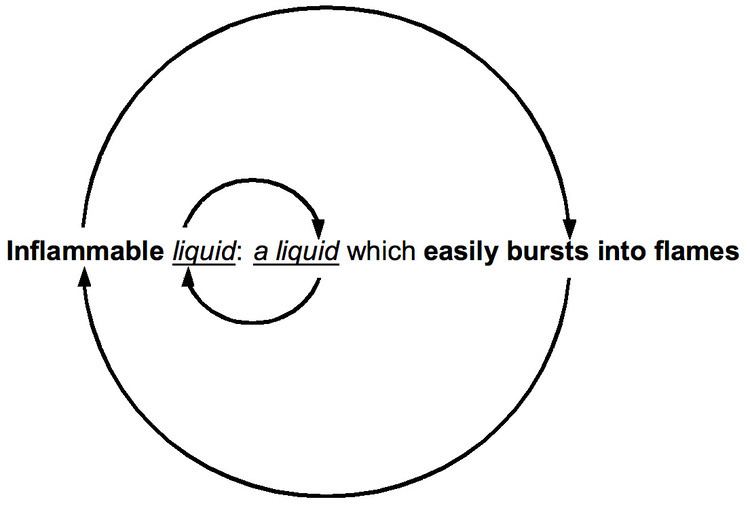 | ||
Fallacies of definition are the various ways in which definitions can fail to explain terms. The phrase is used to suggest an analogy with an informal fallacy. "Definitions that fail to have merit because they are overly broad, use obscure or ambiguous language, or contain circular reasoning are called fallacies of definition." Three major fallacies are overly broad, overly narrow, and mutually exclusive definitions, a fourth is incomprehensible definitions, and one of the most common is circular definitions.
Contents
Circularity
If one concept is defined by another, and the other is defined by the first, this is known as a circular definition, akin to circular reasoning: neither offers enlightenment about what one wanted to know. "It is a fallacy because by using a synonym in the definiens the reader is told nothing significantly new."
A straightforward example would be to define "Jew" as "a person believing in Judaism", and "Judaism" as "the religion of the Jewish people", which would make "Judaism" "the religion of the people believing in Judaism."
Incongruity: overly broad or narrow
A definition intended to describe a given set of individuals fails if its description of matching individuals is incongruous: too broad (excessively loose with parameters) or too narrow (excessively strict with parameters). For example, "a shape with four sides of equal length" is not a good definition for "square", because squares are not the only shapes that can have four sides of equal length; rhombi do as well. Likewise, defining a "rectangle" as "a shape with four perpendicular sides of equal length" is not useful because it is too narrow, as it describes only squares while excluding all other kinds of rectangles, thus being a plainly incorrect definition.
If a cow were defined as an animal with horns, this would be overly broad (including goats, for example), while if a cow were defined as a black-and-white quadruped, this would be both overly narrow (excluding all-black or all-white cows, for example) and overly broad (including Dalmatians, for example).
Obscurity
Definitions can go wrong by using ambiguous, obscure, or figurative language. If "beauty" is defined as "aesthetically successful", one must continue to break down and define the following definition. This can lead to circular definitions. Definitions should be defined in the most prosaic form of language to be understood. Failure to elucidate provides fallacious definitions.
An example is Samuel Johnson's definition for oats: "A grain, which in England is generally given to horses, but in Scotland supports the people."
Mutual exclusivity
The definiens of mutually exclusive definitions list characteristics which are the opposite of those found in the definiendum. An example would occur if a cow were defined as a flying animal with no legs.
Self-contradictory requirements
Definitions may fail by imposing conflicting requirements, making it impossible for them to apply to anything at all. An example would occur if a cow were defined as a legless quadruped.
Definist fallacy
The definist fallacy is a logical fallacy, coined by William Frankena in 1939, that involves the definition of one property in terms of another.
